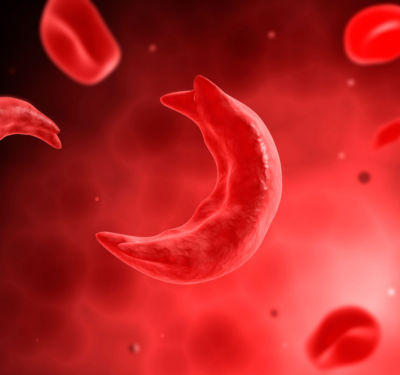A potential therapeutic agent for sickle cell anaemia
A team of scientists in Iraq believe they found a relationship between complications of sickle cell anaemia and oxidative stress.
Published online 29 February 2016

In sickle cell disease, the red blood cells become deformed into a crescent or sickle shape.
© Stocktrek Images, Inc. / Alamy Stock Photo
Sickle cell anaemia is an inherited disease in which red blood cells become rigid and change from the normal disc shape characteristic of these cells into a sickle-like shape. These abnormally shaped cells stack together and can obstruct small blood vessels, leading to severe pain and tissue damage. They are also fragile and can often burst apart, giving rise to anaemia.
Patients with sickle cell anaemia produce 10 to 30 times more of a natural by-product of oxygen metabolism called reactive oxygen species (ROS) than healthy patients. Oxidative stress is an imbalance that results when more ROS are produced than the body’s antioxidant defences can handle. It is thought to be behind certain dysfunctions in people with sickle cell anaemia.
A team of researchers in Basra in southern Iraq studied 42 patients with sickle cell anaemia and found evidence of alterations in the levels of oxidative stress markers, indicating oxidative stress. They also found increased levels of ROS that were associated with decreased levels of antioxidant enzymes and their co-factors.
“The results suggest that these antioxidant enzymes can be used as effective therapeutic targets for the treatment of this disease. Also, supplementing patients with substances that possess antioxidant properties could reduce the complications of the disease,” says biochemist Lamia Al-Naama, the lead author of the paper. Substances that decrease the frequency of episodes of red blood cell destruction or employing molecular approaches that can reduce ROS production could alter the course of the disease and the incidence of associated complications, she adds.
The sickle cell trait is found in 6.5% of southern Iraqis. The estimated incidence of children born with two sickle cell genes (homozygous for the disease) and thus demonstrating characteristics of the disease is about one in one thousand births.
Al-Naama says it is now vital to conduct further research to understand the ethnic and geographic origins of the sickle cell gene present in southern Iraqis. “This would contribute to a better understanding and interpretation of the clinical variety and seriousness of sickle cell anaemia patients [in the region],” she says.
One question the team plan to investigate is whether similar observations would be found in patients with different genetic — and thus ethnic and geographical — origins of sickle cell anaemia. They will also research the effects of antioxidant enzymes or their mimics as antioxidant supplements in sickle cell anaemia patients.
Reference
- Al-Naama, L. M., Hassan, M. K. & Mehdi J. K. Association of erythrocytes antioxidant enzymes and their cofactors with markers of oxidative stress in patients with sickle cell anemia. Qatar Med. J.2015, 14(2015). | article
DOI: 10.1038/qsh.2016.100

